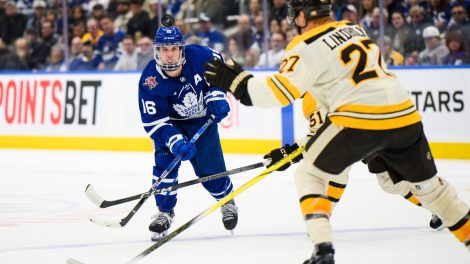ST. JOHN’S, N.L. — The first thought for anyone with a vested stake in the Toronto Maple Leafs should be ‘Thank God.’
Thank God Mitch Marner’s contract stalemate ended before it went right off the rails. Thank God the 22-year-old winger will be able to join his teammates with plenty of time still left in training camp. Thank God the front office made good on Kyle Dubas’s promise to keep all of the young stars in the fold.
Elsewhere, there will be plenty of barely-muffled complaints.
Not only does Marner’s market-resetting $65.358-million, six-year extension instantly complicate life for other teams still negotiating with restricted free agents (hello Mikko Rantanen!), it marks the third straight major contract where Toronto stretched itself to the limit to get things done.
They’ve done it because they believe a core built around Marner, Auston Matthews, William Nylander, John Tavares and Morgan Rielly is good enough to compete for the Stanley Cup. The Leafs made the final push to sign Marner on Friday because this is clearly an all-or-nothing season and it didn’t serve anyone’s interests to have the standoff drag on any longer.
Toronto now carries three of the seven highest cap hits in the league — with Matthews (No. 3, $11.634M), Tavares (No. 5, $11M) and Marner (No. 7, $10.893M) — and it has to hope the incoming U.S. television deals and the arrival of an expansion franchise in Seattle help fuel more league-wide growth in the years to come.
If that happens and young stars continue breaking the bank on their second contracts, these deals may come to look less onerous from a cap perspective.
The compromise in the Marner contract came on the length of the agreement. The player’s camp had wanted to keep it to a three-year deal, but wound up seeing him become the NHL’s second-highest paid winger behind Artemi Panarin when it eventually accepted a six-year term instead.
[snippet id=4167285]
That buys two seasons of unrestricted free agency and clearly establishes the window this organization has to compete for a championship with Matthews and Nylander due for new deals in 2024 and Marner and Tavares signed through 2025.
This year may be their best chance of all. Tyson Barrie, Jake Muzzin and Cody Ceci are all playing on expiring deals and will fill three of Toronto’s top four spots on the blue line. They’ve got improved depth at every position.
"We also think we’ve really taken a step internally," head coach Mike Babcock said Thursday. "What I mean by that is a lot of our core players have gotten substantially better. We’ve gotten older. They’re more comfortable with themselves and they’re more comfortable on the ice both offensively and defensively."
They should certainly be able to count on more growth from Marner and he’s already been their top point producer for two seasons running. He had a career-best 94 points last year while also effectively adding penalty killing duties to his repertoire.
At even strength, Marner was the heartbeat of a lethal line with Tavares and Zach Hyman and led the league in primary assists. Expect that trio to be reunited once Hyman is ready to return from off-season surgery on his ACL at some point in November.
Their other top line is built around Matthews and Nylander, with Alex Kerfoot and Kasperi Kapanen expected to form two-thirds of the third unit. At full health and with everyone performing, they’ll be a handful to match up against.
"Let’s be honest: I mean we’re a good, good team in the National Hockey League," said Babcock. "It’s taken some time to get here, but now we’re a team that we feel like we have an opportunity each year. …
"We didn’t have an opportunity in the past."
[snippet id=3816507]
They’ve arrived here through a patient build that landed Nylander (No. 8 in 2014), Marner (No. 4 in 2015) and Matthews (No. 1 in 2016) with high picks in consecutive drafts. Now that each of those players has graduated from the entry-level contract system and is getting paid commensurate with his performance, the pressure shifts to management to find creative ways to keep building a competitive team around them.
The biggest challenge down the road will be properly staffing the blue line — the development of prospects Rasmus Sandin and Timothy Liljegren is more important than ever — while determining how to proceed when No. 1 goaltender Frederik Andersen’s contract expires in 2021.
However, those are worries for another day.
The organization had once hoped their young stars might take a discount to stay together, but that never materialized. Still, part of president Brendan Shanahan’s message from last October rings true today.
"What I hope they can look back on 20 years, 30 years down the road, what’s going to be most important to them is whether or not they maxed out as an individual and as a team and have championships to look back on and remember forever," said Shanahan.
That’s still possible.
The window isn’t as wide as it might have been, but it’s cranked open until further notice.
[relatedlinks]









